Container gardens are ideal for new gardeners, those with limited space, or those who want to glow up their balcony or patio. Some of the most popular plants to grow in containers are flowers and herbs. Many gardeners rotate the plants they grow throughout the year to maintain a constant supply of colour. Your choice of the planter will depend on your style, the location where it will be placed and how much weight it will be able to bear. A broad selection of materials and designs are available, so you’re sure to find a pot that suits your needs.

Learn how to choose a container and soil for your container gardening in Illinois and other essential steps necessary for the effective growth of a container garden. In addition to this, we have included a list of the many fruits, vegetables, herbs, and flowers to grow in Illinois containers. Container gardening has been more popular throughout Illinois, with several communities, including Chicago, Aurora, Naperville, and Joliet, serving as regional epicentres for the trend. So let’s check out more information about Illinois container gardening.
What are the USDA hardiness zones (planting zones) of Illinois state?
The length of Illinois, which is close to 400 miles, and its location in the middle of the continent cause the state to have a quite diverse climate and help determine where planting zones are located. The bulk of the state is characterised by a humid continental climate, characterised by hot, lengthy, and rainy summers and winters that are chilly. The prevalence of extremes characterises both sections of the state.
The climate in the southern half indicates a humid subtropical climate, but the climate in the northern half is described as having mild summers and humid continental conditions. Each year, the state sees an annual average of close to fifty days of thunderstorm activity, which places it slightly over the national average for the whole country. And depending on where you are, the annual precipitation might vary anywhere from 35 to 48 inches on average.
The average annual snowfall in the south might be as little as roughly 14 inches, whereas the Chicago area can get up to 38 inches. The planting zones in Illinois span from 5a to 7a, with 5a being the lowest planting zone and 7a being the highest planting zone in the state. Before beginning to design a garden, it is essential to study the planting zones unique to the garden’s area.
Planting zones determine not only what but also when to plant, and as a rule of thumb, a good gardening season can be achieved by planting anything rated for the indicated zone or below. The dates of the first and the final frosts are used to categorise areas. Any planting zone in Illinois will provide access to a diverse selection of flowers and vegetables. Hostas, peonies, yarrow, daylilies, and allium are all excellent selections for flower gardens since they are simple to grow and need little attention.
Additionally, a wide variety of crops are not challenging to grow in this region. Plant vegetables such as beans, beets, tomatoes, kale, spinach, peas, and Brussels sprouts in your vegetable gardens. These are just a few examples. Plants with attractive leaves, such as coleus and jack-in-the-pulpit, are particularly successful in almost every state region.
Illinois container gardening: Steps to grow plants in containers
Make sure you choose an ideal pot
Choosing the appropriate container to grow plants in is, not surprisingly, the most important aspect of container gardening. Almost anything containing soil may be used as a container for a garden, from plastic containers and cinderblocks to whiskey barrels and wheelbarrows. When it comes to growing a fruitful container vegetable garden, consider these three factors:
Drainage
A container must be equipped with a drainage hole or another method that enables water to escape from within the container. The presence of water in the soil encourages the development of bacteria and fungi, both of which reduce the production of plants or even cause their death. Your local climate is also an important consideration; gardeners who live in drier places may want to use containers that hold more moisture, while gardeners who live in more humid conditions may desire containers that allow better air movement.
Size
In general, you will get better results from the growth of your plants if you can provide their roots with a greater amount of room. Most veggies need at least 12 inches of soil to ensure healthy growth, although those crops with a broader footprint will need more room. A five-gallon container is recommended when growing plants with deep roots, such as tomatoes or squash.
On the other hand, growing plants with shallow roots, such as lettuce or other greens, requires only a container with one to two gallons. Keep in mind that bigger containers will be heavy and more difficult to transport than smaller ones and that they can be too heavy for places like balconies. On the other hand, small containers are more movable and adaptable, but they also tend to dry up more quickly, which needs greater care when the temperature is high.
Material
The container’s material is the last significant aspect to think about, and it should be one of your top priorities. These days, there is a wide variety of container options like plastic, ceramic, and fabric, and each has its perks and cons.
Choose the best potting mix
It is necessary to have good soil to develop healthy plants. To develop strong roots and ensure a successful harvest, plants grown in containers need the highest-quality fertiliser, aeration, and drainage. It is not appropriate to utilise the soil from the garden! Most soils used for gardening are overly heavy, meaning they rapidly get waterlogged and compacted and serve as a breeding ground for disease and insects.
In case you missed it: Potting Soil Mix for Flowers – Preparation Method
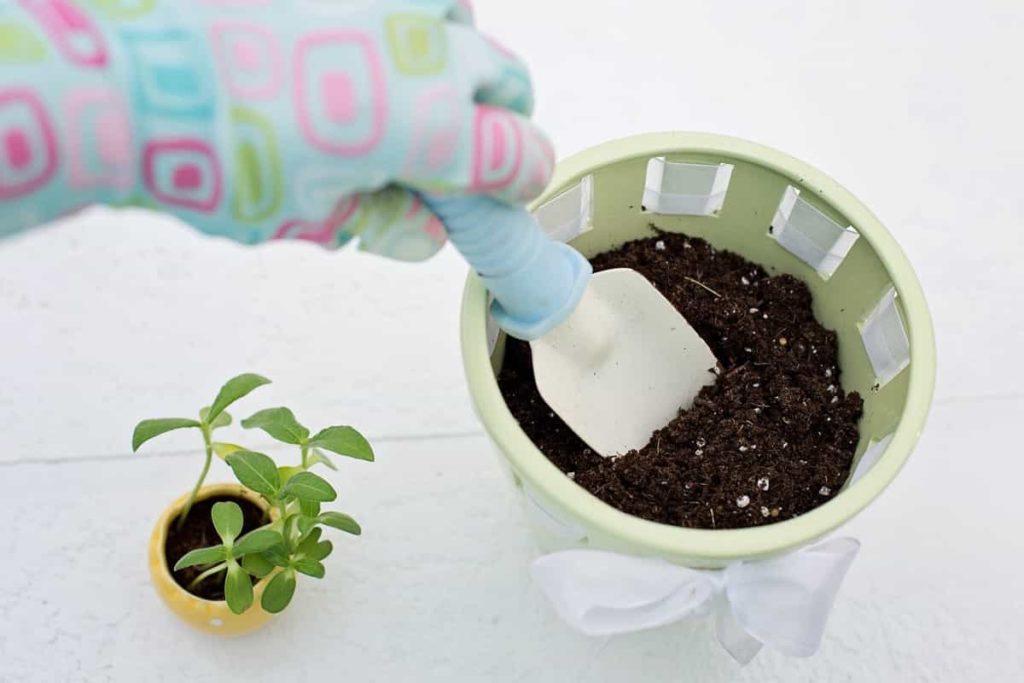
Instead, you should use a “soilless” potting mix, a kind of potting mix that has been developed for use in containers. It will be lightweight, quick-draining, and should be free of any infections or pests that can be present. Peat, perlite, and vermiculite are often the primary components of soilless potting mixes. Other nutrient-delivering components, such as crushed limestone and granulated fertilisers, may also be used. The addition of humus to the mixture in your container is highly recommended since it loosens the media and includes a wealth of nutrients.
Now start planting your plants
As soon as you’re ready to put in new plants, gently compress their nursery pots to free their root balls. To prevent the plant from being injured, you should steer clear of pulling on it directly. Instead, your plants should be placed in the potting mix with their root balls just a few inches above the container’s lip.
This will make watering the plants later a lot simpler for you. The potting mix can be added to the plants’ area, but the stems should not be buried deeper than in the nursery pots. Instead, use your hands to provide gentle pressure to the mix around your plants to minimise huge air pockets.
Water your container plants
Growing material inside containers will get completely dried more quickly than soil outside. As a guideline, water your plants when the top inch or so of the growing media feels dry. Be sure to give plants a good amount of water until it begins to seep through any drainage holes. Be careful to empty any water that accumulates in a plant saucer that you have placed regularly beneath your plant’s container.
This will assist in preventing the soils from being too damp and remove possible breeding grounds for mosquitoes. Container plants may require daily watering in hot, dry conditions. To avoid problems with drying out, avoid using unglazed ceramic pots in favour of glazed or plastic versions.
How to fertilise your container plants?
The nutritional content of the soilless medium is often relatively low. Consequently, the plants that are developing inside them could need additional fertilisation. You have the option of using either liquid or slow-release fertilisers. Use slow-release fertilisers. When it becomes moist, this coating will let out trace quantities of the nutrients it contains. So, it’s essential to water the soil appropriately if you want these fertilisers to operate effectively.
Most of the time, these products will give nutrients for three to four months. Fertilisers with a controlled release rate are often blended with bagged potting material. When liquid fertilisers are combined with water and then applied to containers when watering plants, the plants may absorb the nutrients almost instantly.
They are typically administered once every two weeks but can be done more often if the solution is diluted and utilised more frequently. When applying fertiliser to your plants, you must do it by the instructions provided on the product’s label to prevent causing harm to your vegetation.
What are the best ways to manage pests and diseases?
There are several different factors by which container plant pests might be transmitted. First, they may arrive in the same nursery container that the plant was grown in. They could be found in soil that has been used before, such as potting soil or soil was taken from the garden. Fruits and contaminated plants can also be a source of infection, which is an interesting fact. Finally, there is a great abundance of insects searching for places to eat and nest in the open air.
Many times, your plants will supply the perfect lodgings and forage. A container that has been used before but not cleaned properly can also retain insect pests. Container plant pests can colonise in various ways, becoming a significant source of watering for you while also posing a significant risk to the health of your plants. It can be a great pain to get rid of many different insects once they have set up shop in your home.
Fungus gnats are responsible for one of the most prevalent pest issues associated with containers. Although they are quite little and difficult to see, you may be able to notice them darting about the soil of your plant if the light is bright enough. The insects will bury their eggs in the ground, where the larvae develop. The larval stage consumes roots and other items found near the earth.
Mealybugs, ants, nematodes, white flies, aphids, scales, leafminers, springtails, spider mites, pillbugs, and thrips are more common pests found in containers. Mealybugs are also known to feed on the scale. Because it might be hazardous to your health, you should avoid bringing heavy pollutants into the house and instead depend on non-toxic controls. Using an insecticide that contains neem oil is a risk-free method of warding off unwanted bug guests. Soaps that kill insects are another helpful tool.
The scent of herbal oils repels many insects. Oils with a strong aroma and taste, such as peppermint or clove, are excellent for their ability to discourage the behaviour. Many insects can be driven away using a spray made of hot pepper. Many soft-bodied insects can be killed on contact with rubbing alcohol that has been administered with a cotton swab. To make a spray that can be used for various purposes, combine a little amount of dish soap, frying oil, and water. Try jazzing it up with some pepper, garlic, or herb oil to boost efficiency.
Top vegetables to grow in containers in Illinois state
Many vegetables can be grown in Illinois in containers, such as asparagus, beans, beet, broccoli, carrots, cucumbers, eggplants, lettuce, okra, onions, peas, peppers, potatoes, spinach, and tomatoes and other vegetables. Some of the details are given below.
Beans: The majority of the bean plants are climbers or bushier varieties, and they grow in an upward direction. You can grow them on a trellis near a wall, and in a matter of weeks, you will have a decent wall of beans flowing over the trellis.
Lettuce: When growing lettuce, it is best to use a broad planter rather than a deep one. Use soil that drains effectively and water your plants in little, regular amounts.
Peppers and chillies: Both peppers and chillies are very prolific plants, making them ideal choices for growing in pots. They flourish best in bright, warm environments and look fantastic when grown in containers.
In case you missed it: Growing Bell Peppers On Terrace – Organically
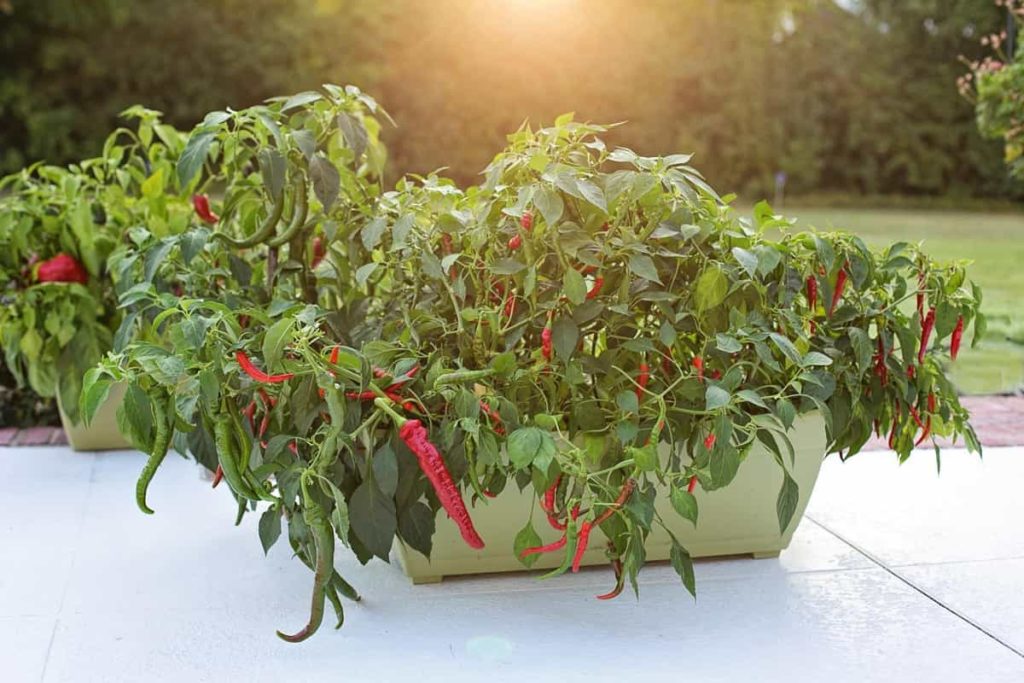
Spinach: One of the most successful crops to grow in containers is spinach. It does well even in shaded conditions. It is also simple to grow spinach in pots in Illinois. It is even possible to grow it on a windowsill inside the house.
Carrots: Cooler temperatures are optimal for carrot growth. They need consistent irrigation and soil that is consistently wet.
Top fruits to grow in containers in Illinois state
Many fruits can be grown in Illinois in containers such as blackberries, blueberries, gooseberries, raspberries, strawberries, apricots, apples, pears, cherries, plums and other fruits. Some of the details are given below.
Strawberries: These are very easy to grow in pots. Take care to place them in an area that receives a lot of sunlight. Level the crown with the compost.
Raspberries: You can plant raspberries that fruit in the summer and those that fruit in the fall in pots, allowing you to enjoy your bounty for many weeks. Choose summer fruiting kinds, which are less invasive, if you have a limited amount of room. Locate them in a shady yet sunny area.
In case you missed it: Growing Raspberries Indoors in Pots (Containers)
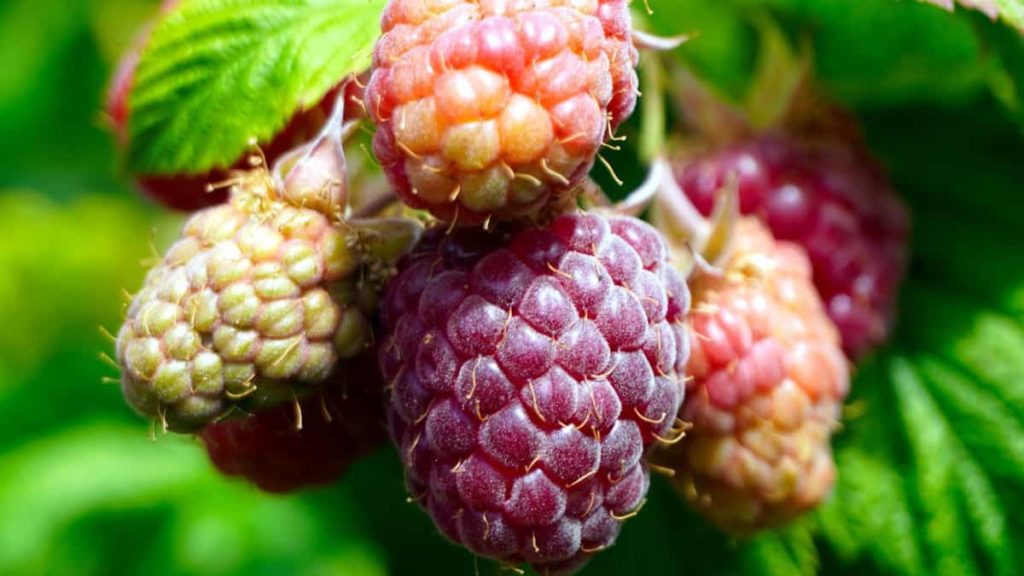
Plums: It is also possible to relocate potted plums to a location where they can be protected from frost by covering them with fleece. Plums need a lot of grit in their compost to help with drainage. If you have space for one plant, go for a self-fertile type.
Peaches and nectarines: It is possible to plant peach and nectarine trees in a shaded or sunny location, but the blooms will not survive the winter. Cover it with fleece when the tree’s blooms begin to bloom to keep them safe. Every two years, repot.
Gooseberries: Gooseberries produce a lot of fruit in a small area because of their high productivity. They prefer a sunny, protected location, although they will give fruit even in partial shade. To encourage optimum air circulation around the plants, leave some space around the container as gooseberries.
Top herbs to grow in containers in Illinois state
Many herbs can be grown in Illinois in containers, such as basil, cilantro, mint, oregano, parsley, rosemary, chives, coriander, sage, tarragon and other herbs. Some of the details are given below.
Mint: This is an excellent container crop because of its many uses. However, it’s a hungry beast that needs frequent feeding to thrive. Pick and water each plant regularly, then place it in a five-litre container. Re-potting with new compost following each spring’s winter dieback will keep your plant healthy after it has become established.
Chives: Snipped over soups or salads or garnished with them, they’re a wonderful addition to any meal. Flowers in the spring are cheery and delicious, and the bees like them. This is a simple plant to grow, requiring four or five hours of direct sunlight each day. As chives need humid soil, make sure it doesn’t dry out.
Parsley: This takes a long time to germinate from seed, but once it does, it will provide you with leaves for over two years before flowering and dying.
Coriander: When coriander is planted in the spring, it blooms fast and sets seed. Even if you maintain the plant properly watered, nourished, and in a more shaded location, it will ultimately succumb to the effects of over-watering and under-feeding. Although the blooms are attractive to hoverflies, which feed on aphid larvae, don’t worry: the green seeds on the petals are tasty. The optimum period to plant coriander is August to September when it is less likely to bolt.
In case you missed it: Coriander Growing Tips, Techniques, and Secrets
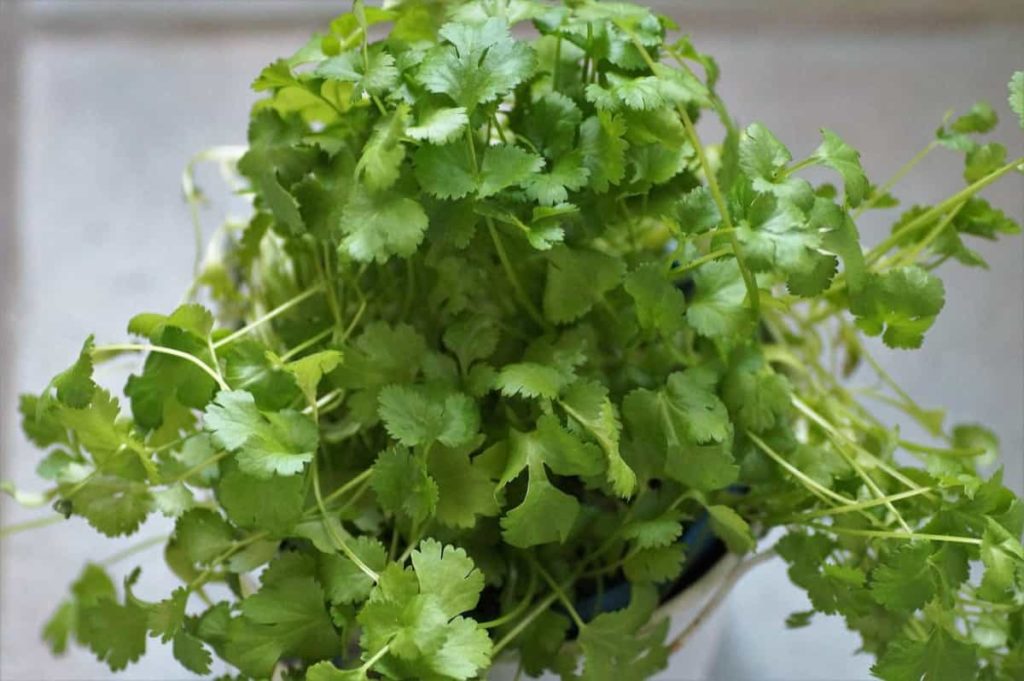
Basil: This is a fan of the heat. Sown in June as the weather heats up, it grows best in a sunny, warm, protected location. For this reason, it prefers well-drained soil and watering in the morning.
Top flowers to grow in containers in Illinois state
Many flowers can be grown in Illinois in containers such as hostas, coral bells, hibiscus, salvia, daylilies, coreopsis, asters, coneflowers, blanket flowers, baptisia and other flowers. Some of the details are given below.
Daylilies: To increase the blooming period of your daylilies, you should plant early, mid, and late-season flowers. Daylilies thrive in full to partial light and on medium, well-drained soil. USDA plant hardiness zones 4 to 9 are suitable for these plants.
Hostas: Hostas are prized for their showy leaf and mounding habit. As a general rule, Hostas vary in height from 12 to 18 inches to 5-foot monsters. Full sun is OK as long as there is some afternoon shade for the Hostas. They like soil that is medium in texture but drains well. Depending on the variety, Hostas are hardy in USDA zones 3–9.
Hibiscus: There is a common misconception that hibiscus blooms can only be produced in subtropical or tropical gardens. However, these herbaceous perennials may be effectively grown in Illinois containers. In the summer, hardy hibiscus plants can grow to 3 to 5 feet. A touch of colour can be achieved in a flowerbed with blooms up to 10 inches in diameter. Hibiscus grows best on ordinary, well-drained soil with full to partial sun exposure. Depending on the cultivar, Hardy Hibiscus can be grown in USDA hardiness zones 4–9.
In case you missed it: Best Fertilizer for Hibiscus: Homemade, Organic, Liquid, NPK, and Compost Manure
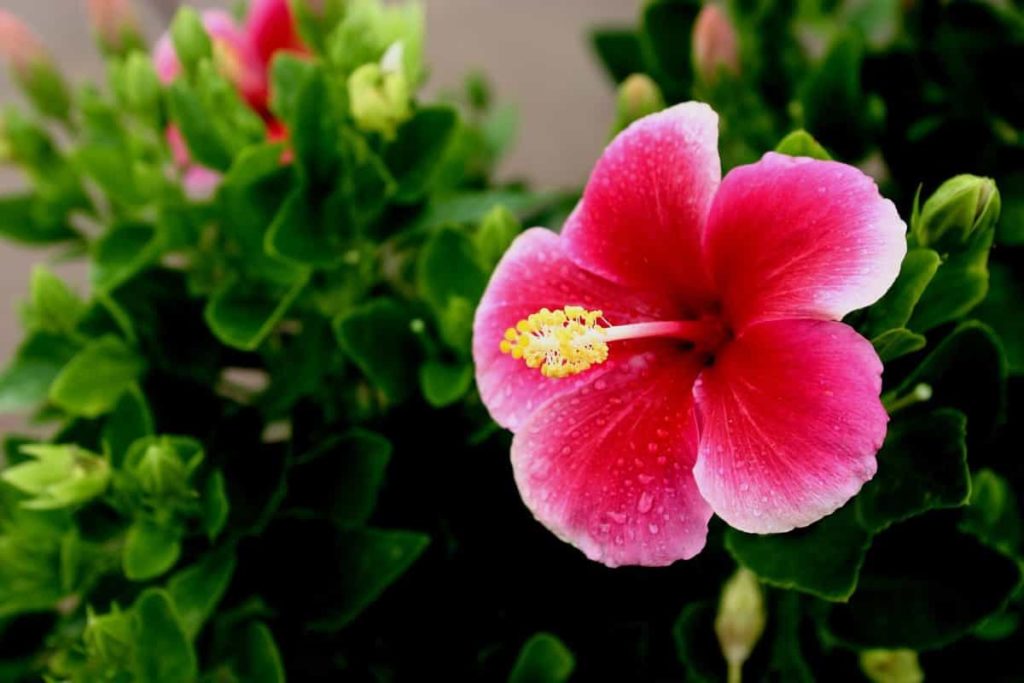
Salvia: This flower begins to bloom in the early to middle stages of summer and can continue to do so well into the autumn months if you diligently remove spent flowers from the plant. They prefer full or partial sunlight. A wide range of USDA plant hardiness zones 5 to 10 are suitable for their growth.
Coreopsis: Carefree perennial coreopsis flowers for months on end when deadheaded regularly. They can grow from 18 inches to four feet in height. Coreopsis is happiest when grown in full sun and on soil sandy or loamy and has good drainage. Zones 3 to 10 are suitable for growing it.
- Growing Gold: Essential Techniques for Planting Pineapples
- How to Make Kalanchoe Plant Bushy: Home Remedies and Solutions
- 11 Reasons Why Your Gardenia is Not Blooming: Home Remedies and Solutions
- Eco Elegance: The Guide to Designing a Drought-Tolerant Landscape
- Gardening on a Slope: Strategies for Hillside Landscaping
- Nourish and Flourish: Top Organic Mulches for Thriving House Plants
- Everything You Want to Know about Indian Mogra Flower: Discover Uses and Growing
- Green Thumb Success: Expert Tips for Cultivating Greenhouse Pumpkins All Year Round
- Maximize Growth & Flavor: The Ultimate Guide to Companion Planting in Herb Gardens
- How to Control Rhododendron Problems Naturally: Home Remedies and Organic Ways to Fix Them
- Natural Magic: The Remarkable Benefits of Cinnamon for Plants
- Best Steps to Revive Dying Tulip with Natural and Organic Treatment
- 10 Reasons Why Your Angel Trumpet is Not Blooming: Remedies and Treatment
- How to Fix Periwinkle Leaf and Flower-Related Problems: Natural Remedies and Solutions
- How to Fix Zinnias Leaf and Flower Problems: Discover Natural and Home Remedies
- Organic Steps to Induce Lemon Tree Flowers: A Comprehensive Guide
- Bloom Booster: Crafting the Perfect Homemade Bougainvillea Fertilizer
- Optimizing Growth: A Guide to Applying NPK Fertilizer for Potted Plants
- 10 Best Homemade Fertilizers for Rubber Plant: DIY Recipes and Application Method
- How to Boost Female Pumpkin Flowers: Effective Steps for More Flowers and High Yields
- Transform Your Indoor Garden: Top Benefits of Pink Salt for Houseplants
- 10 Best Homemade Fertilizers for Peacock Plants (Calathea): Easy DIY Guide
- Unlock Blooms: 9 Reasons Why Your Potted Chrysanthemum is Not Blooming
- 8 Reasons Why Your Potted Hibiscus is Not Blooming: Fix it with Simple Solutions
- Unlock Blooms: 9 Key Reasons Your Potted Frangipani Won’t Flower
- 10 Reasons Why Is My Ice Plant Not Blooming: Remedies and Treatment
- 10 Reasons Why My Potted Hydrangea Not Blooming: Treatment and Remedies
- 10 Reasons Why is My Wisteria Not Blooming: Remedies and Treatment
- 10 Reasons Why is My Goldfish Plant Not Blooming: Remedies and Treatment
- Maximize Your Space: Ultimate Guide to Balcony Gardening with Grow Bags
- 10 Reasons Why Your Iris is Not Blooming: Remedies and Treatment
- 10 Reasons Why Your Anthurium Plant is Not Blooming: Treatment and Remedies
- 10 Reasons Why Your Aquaponic Plants Are Not Flowering: Remedies and Treatment
- 10 Reasons Why Your Agapanthus is Not Flowering: Remedies and Treatment
- Ultimate Guide to Brown Turkey Fig: Steps to Growing Brown Turkey Figs
- How to Grow Acai Berry: Propagation, Planting, and Care